Battle of Austerlitz
49.128055555616.76222222Coordinates: 49° 7′ 41″ N, 16° 45′ 44″ E
Battle of Austerlitz
Part of: Third Coalition War
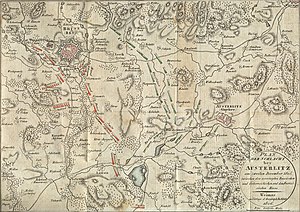
Plan of the Battle of Austerlitz on the second of December 1805.
Third Coalition War (1805)
Cape Finisterre - Wertingen - Günzburg - Haslach-Jungingen - Elchingen - Ulm - Trafalgar - Caldiero - Ried - Lambach - Bodenbühl - Steyr - Amstetten - Mariazell - St. Pölten - Cape Ortegal - Dürnstein - Schöngrabern - Wischau (Vyškov) - Austerlitz
The Battle of Austerlitz (French Bataille d'Austerlitz, Czech Bitva u Slavkova, Russian Битва под Аустерлицем), also called the Battle of the Three Emperors, although the Austrian Emperor Francis I was not present on the battlefield, took place on Monday, December 2, 1805, exactly one year after Napoleon I was crowned Emperor in Paris. It is one of the most famous battles of the Napoleonic Wars. At Pratzeberg, between Brno and Slavkov u Brna in Moravia, Emperor Napoleon I of France defeated an alliance of Austrian and Russian troops - the latter under Emperor or "Tsar" Alexander I of Russia.
Campaign of 1805
After the relatively peaceful years of 1803 and 1804, Britain and Russia signed a treaty in April 1805 to occupy France's Dutch daughter republic and Switzerland, which was under French protection. Austria joined the alliance after Genoa was incorporated into France and Napoleon was proclaimed King of Italy. Napoleon was now preparing to invade England and had assembled invasion forces of 150,000 men at Boulogne for this purpose.
Faced with the looming superiority of Great Britain, Russia and Austria, Napoleon intended to strike the great powers one by one. The lack of coordination between the coalition forces provided him with the opportunity to do so: Austria and Russia had ignored the different calendars in Austria and Russia in their deployment plans, so that the Austrians advanced towards Bavaria. In great haste the French Grande Armée was withdrawn from the English Channel and thrown eastward. The first blow struck with a lightning campaign against the Austrians at Ulm (25 September to 20 October 1805), while General Karl Mack of Leiberich was forced to surrender with part of his army. This left the way to Vienna open to Napoleon: After minor skirmishes along the Danube, his troops succeeded in taking Vienna without a fight on 13 November. More French troops were advancing from Italy. Napoleon pursued the retreating Russians towards the Moravian city of Brno, as he wanted to force a decisive battle before the superior enemy forces could unite. In particular, Napoleon wanted to avoid a looming entry into the war by Prussia. Therefore, he lured the Russians and Austrians into a battle by skilfully feigning their own weakness, which - depending on the linguistic usage - went down in history as the Battle of Austerlitz or the Battle of Austerlitz.
Battle
Weather
Before the battle, the temperature was between 1 and 2.5 degrees Celsius. On the evening of December 1, 1805, the cloudy-overcast weather changed to a cloudless night. On December 2, dense ground fog prevailed, only giving way to Austerlitz sunshine in the morning. The temperature during the battle was about 5 degrees, the afternoon sky was cloudy with intermittent rain. The historian Uhlíř collected the following meteorological data for the city of Brno:
| Date | ds. Temp. | Wind | Weather |
| 29.11. | 1,1 °C | weakly | Rain, fog |
| 30.11. | 2,0 °C | weakly | Snowfall |
| 1.12. | 2,5 °C | medium | Fog |
| 2.12. | 5,2 °C | weakly | Fog, rain |
| 3.12. | 2,5 °C | weakly | Sleet |
Battlefield
The battlefield encompasses a square with a side length of approx. 12 km, which is determined by two traffic axes: To the west lies the south-north route from Vienna to Brno (Napoleon's only supply line) and to the north the east-west route from Olomouc to Brno (the Russians' line of approach). A south-eastern branch of this road leads to the small town of Austerlitz, after which the battle is named.
In the southwest, two then swampy ponds, which were partially frozen, bordered the battlefield. From these, the Goldbach flows in a northerly direction until it crosses the road to Olomouc. Northeast of this crossing is Santon Hill, which served as Napoleon's headquarters during the battle. To the south, along the Goldbach stream, are the smaller villages of Telnitz and Sokolnitz. From southeast to northwest, the battle-deciding, gently rising Pratzeberg stretches diagonally.
Plans
The Allies discussed their plans in the village of Krenowitz, where both the Russian Tsar Alexander I and the Austrian Emperor Franz II/I had set up their headquarters. Despite their numerical superiority and Napoléon's cleverly feigned weakness, Emperor Francis II/I and General Kutuzov hesitated to launch an attack, for their side was expecting reinforcements. Tsar Alexander I, however, encouraged by Prince Dolgorukov and other nobles, and supported by the Austrian general and chief of staff Franz von Weyrother, decided to attack. General von Weyrother, who was familiar with the terrain, drew up the plans of attack, which were read out to the assembled generals at 1:00 a.m. on December 2, 1805. Many generals could not maintain their concentration at such a late hour, and General Kutuzov is even said to have dozed off during the process. Poor communication and lack of questioning of the plans initiated some of the later problems.
The plan of the Allies with their troop strength of about 85,400 men (including about 16,000 Austrians) provided for an attack on both wings of the French, in which the Allies were divided by General von Weyrother into seven sub-forces (columns). On the right wing, 13,000 men under Russian Lieutenant-General Bagration, supported by 4,600 cavalry (5th column) under Field Marshal Liechtenstein (at the same time commander-in-chief of the Austrian part of the forces), were to tie down the French forces on the road from Brno to Olomouc.
The main Allied attack on the left wing with 59,300 men was intended to cut Napoléon off from his supplies from Vienna and throw him back towards Brünn. The Austrian cavalry vanguard under Field Marshal Kienmayer (5,100 men) was to pave the way for the 1st Column (8,500 men) under Lieutenant General Dochturow to capture the village of Telnitz. The 2nd Column (11,700 men), under the French exiled Lieutenant-General in Russian service Langeron, was meanwhile to capture the village of Sokolnitz a little further north, supported by the 3rd Column (10,000 men) under Przybyszewski. The commander of these three Russian columns was General der Infanterie Buxhöwden. The 4th Column (23,000 men) under the command of Lieutenant General Kolowrat and Lieutenant General Miloradovich in the center was to reinforce the successful attack of the three columns. The Russian Guard (8,500 men) under Grand Duke Constantine, the Tsar's brother, was held in reserve north of the headquarters at Krenowitz.
Napoleon had already communicated his plan to his generals the night before, at 20:30 on 1 December 1805. His 73,000-man army was to deploy defensively in the first phase; concentrated on the French left wing (equivalent to the Russian right wing). The front line was formed by the V Corps (19,200 men) under Marshal Lannes, supported by Marshal Murat's cavalry reserve (5,600 men), behind them the I Corps (13,000 men) under Marshal Bernadotte, Oudinot's grenadiers (5,700 men) and the Imperial Guard (5,500 men) under Marshal Bessières.
The right wing was held solely by the IV Corps (23,600 men) under Marshal Soult. On the right wing, too, Napoleon concentrated his forces on the left by massing the two divisions Saint-Hilaire and Vandamme near the village of Puntowitz and entrusting only the Legrand Division, supported by the light cavalry brigade Margaron, with the defence of the positions around Telnitz and Sokolnitz threatened by the Russian main attack. Napoleon knew here that parts of the III Corps (6,600 men) under Marshal Davout would arrive early in the morning after a hasty march from Vienna (120 km in 50 hours). As soon as his right flank would be secured, Napoléon intended to let Soult's two massed divisions seize the Pratzen Anthea and thus divide the enemy.
course of the battle
→ List of units of the French army in the Battle of Austerlitz.
South
At 7 o'clock on December 2, 1805, the vanguard under Kienmayer began the attack on Telnitz from Mönitz, which was defended by Legrand's division. When the 1st column under Dochturow was also thrown into battle at 8 o'clock, the French were forced to evacuate Telnitz. At 8:30 the 2nd Column under Langeron, supported by the 3rd Column under Przybyszewski, attacked the village of Sokolnitz until at 9 o'clock, despite a successful counterattack by Davout's replacement forces in the meantime, both villages were in Allied hands. This Allied success was dearly bought: Legrand's division and the forces of III Corps stopped three Russian columns and Kienmayer's advance guard (about two-thirds of the main Russian attack).
Center
Only the unsuspecting 4th column under Kolovrat and Miloradovich, following the other columns, faced Napoléon's main attack. Napoléon asked Marshal Soult how long it took his divisions to occupy Pratzeberg. Less than twenty minutes, Soult replied. Then we'll wait another quarter of an hour, was the Emperor's reply, who wanted to make sure that, if possible, the three Allied columns had already marched off the Pratzenberg onto the flank, thus weakening the center. At 9:00 the fog lifted and the sun began to shine (le beau soleil d'Austerlitz). St. Hilaire's division captured the village of Pratzen and reached the top of the hill. The Vandamme Division on the left met resistance in the village of Jirschowitz. By 9:30 a.m., the French had captured the high ground. The surprise of the Allies was complete. Oberfeldherr Kutuzov was accompanying 4th Column Miloradovich and Kolovrat when he perceived the French in the center. He ordered the column to turn back and drive out the French. Langeron's 2nd column sent Kamensky's brigade to reinforce it. In the meantime, Brigade Jircik was able to recapture the top of the mountain once again. The battle for the Pratzeberg, relentlessly fought by both sides, lasted until 12:00, when the French were victorious. Napoleon ordered the St. Hilaire and Vandamme divisions to swing south and attack the remaining Russian columns.
Napoleon thus exposed the flank of the two divisions to the Russian Guard under Grand Duke Constantine, which had hitherto been held in reserve. The Russian Guard cavalry destroyed a French battalion quickly sent into the breach at 13:00. Napoleon sent the French Guard cavalry under Colonel Morland to stop the Russians. Morland fell, the attempt failed. Only the intervention of General Rapp, a close confidant of Napoleon, with elite Mamluk cavalry led to success. The success of this attack is immortalized in the painting by Gérard. With the Russian guard broken up, the St Hilaire and Vandamme divisions were able to continue their attack of the three Russian columns, which were harassed in the front by Davout's III Corps.
North
In the north, on the road from Brno to Olomouc, the Russian troops under Bagration, supported by Liechtenstein's cavalry, faced the French troops of the V Corps (19,200 men) under Lannes, supported by Murat's cavalry reserve. At 9 o'clock Bagration began his attack against Suchet and Caffarelli's divisions. He tried unsuccessfully to encompass the French left flank. South of Bagration's positions, Liechtenstein's and Murat's horsemen engaged in fierce fighting, supported by units of the I Corps (13,000 men) under Bernadotte. Realizing that he could not break the resistance of the French, Bagration began to extract his units and begin an orderly retreat.
Retreat
The battle was decided, the retreat of the allies was general, and soon degenerated into wild flight. On a narrow causeway stretching between the Satczaner and Mönitzer ponds everything crowded together; some ventured onto the thin ice cover of the ponds and drowned, as it collapsed under the fire of French artillery. The Austrians calculated their loss at 4000 dead, the Russians theirs at 11,000 dead. The French came to 1290 killed and 6943 wounded, took over 12,000 prisoners of war, and boasted of having captured 180 cannon as well as all the baggage. The bronze from the captured cannons was used to cast the Vendôme Column in Paris' Place Vendôme.

Vendôme column on the Place Vendôme in Paris: bronze from the cannons captured by the French at the Battle of Austerlitz was used for the shaft.
.jpg)
Napoléon at the Battle of Austerlitz, painting by François Gérard
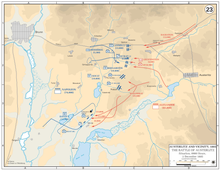
The situation at 9 o'clock on 2 December 1805
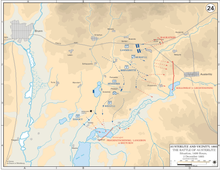
The situation at 2 p.m. on 2 December 1805
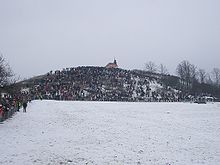
The hill Santon served as a french artillery position

French artillerymen (reenactment shot during the 200th anniversary of the battle)
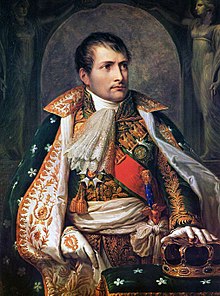
Portrait of Napoleon , painting by Andrea Appiani (1805)
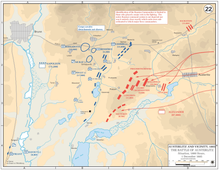
Allied (red) and French troops (blue) at 6 p.m. on December 1, 1805.
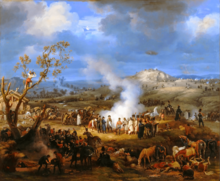
Eve at Austerlitz, painting by Louis-François Lejeune
Questions and Answers
Q: Who did Napoleon Bonaparte fight in the battle of Austerlitz?
A: Napoleon Bonaparte fought Russian and Austrian troops in the battle of Austerlitz.
Q: Where did the battle of Austerlitz take place?
A: The battle of Austerlitz took place near Austerlitz, which is now in the Czech Republic.
Q: When did the battle of Austerlitz take place?
A: The battle of Austerlitz took place in 1805.
Q: What was the result of Napoleon's big victory in the battle of Austerlitz?
A: Napoleon's big victory in the battle of Austerlitz let him create the Confederation of the Rhine.
Q: Who wrote a detailed description of the battle of Austerlitz?
A: Leo Tolstoy wrote a detailed description of the battle of Austerlitz in his book War and Peace.
Q: What is the Confederation of the Rhine?
A: The Confederation of the Rhine was a group of German states that were allied with France under the leadership of Napoleon.
Q: Why is the battle of Austerlitz significant?
A: The battle of Austerlitz is significant because it was one of Napoleon's most decisive victories and led to the creation of the Confederation of the Rhine, which had a lasting impact on the political landscape of Europe.
Search within the encyclopedia